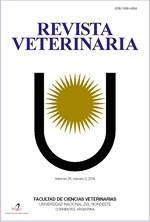Helminths and gastrointestinal protozoa in equines of Corrientes, Argentina
DOI:
https://doi.org/10.30972/vet.3114645Keywords:
Equines, argentinean northeast, nematoda, protozoa, prevalenceAbstract
The objective of this work was to evaluate the gastrointestinal parasites of equines coming from eight localities of the Province of Corrientes, Argentina. By means of concentration techniques, 30 fecal samples were examined in order to identify the helminths and protozoa and to estimate the general and specific prevalence. A general prevalence of P=50% and four taxa (S=4), represented by two protozoa, Blastocystis sp (P=3.3%) and Eimeria sp (P=16.6%) and two nematodes, Strongylus sp (P=13%)and Cyathostomun sp (P=20%.), were recorded. Most reports on parasites in equines refer to nematodes, so the registration of protozoa is a novel contribution to knowledge on the subject. Regarding the identified nematodes, they have been reported in different provinces of Argentina and the large strongyls represent the lowest prevalence while the small strongyls, Cyathostomun genus, represent the highest prevalence. Our findings contribute to the knowledge on the subject and highlight the need of the implementation of sanitary measures in order to control transmission, and to keep parasitic loads below levels that potentially affect the health, productivity or performance of horses.
Downloads
References
Anziani OS, Catanzaritti H. 2005. Resistencia a los benzimidazoles en nematodes de equinos en Santa Fe, Argentina. Vet Argent 218: 571-578.
Anziani OS, Ardusso G. 2017. Resistencia a los antihelmínticos en nematodes intestinales que parasitan a los equinos en Argentina. Rev Investig Agrop 43: 24-35.
Beugnet F et al. 2005. Compendio de Parasitología Clínica de los Équidos, Ed. Academica Kalianxis, Univ.Públ.Navarra, España, https://studylib.es›doc›629253.
Brady H, Nichols W. 2009. Drug resistance in equine parasites: an emerging global problem. J Equine Vet Sci 29: 285-295.
Cerutti J et al. 2012. Resistencia de los pequeños estrongílidos (grupo ciatostoma) a los bencimidazoles en equinos del área central de Argentina. In Vet 14: 41-46.
Chapman CA et al. 2006. Do nutrition, parasitism, and stress have synergistic effects on red colobus populations living in forest fragments?. Am J Phys Anthropol 131: 525-534.
Drudge JH, Lyons ET, Szato J. 1966. Pathogenesis of miugrating stages of helminthes with special reference to Strongylus vulgaris. In: Biology of parasites. Emphasis on veterinary parasites, Academic Press, Londres, p. 199-214.
Drudge JH. 1979. Clinical aspects of Strongylus vulgaris infection in the horse. Emphasis on diagnosis, chemotherapy and prophylaxis. Vet Clin North Am Large Anim Pract 1: 251-265.
Fusé L, Saumell C, Iglesias L. 2013. Variación estacional del parasitismo interno en equinos: fenómeno de hipobiosis de los pequeños estróngilos (Cyathostominae) en Tandil, Buenos Aires, Argentina. Rev Med Vet 3: 62-72.
Godoy K, Odalia A, Rímoli J. 2004. Infecção por endoparasitas em um grupo de bugios-pretos (Alouatta caraya) em um fragmento florestal no Estado Do Mato Grosso Do Sul, Brasil. Neotrop Primates 12: 63-68.
González AC, Giraldo JC. 2015. Prevalencia de parásitos intestinales zoonóticos en caninos (Canis lupus familiaris) del área urbana del municipio de Coyaima (Tolima). Rev Med 23: 24-34.
Herrick JB.1990. Hidden losses: conquering coccidia. Large Anim Vet 45: 29-30.
Irurzun E. 2014. Identificación de estróngilos en 3 explotaciones de equinos en Arakil. Tesis Univ. Públ. Navarra, España, https://academica-e.unavarra.es.
Kaplan R. 2011. It is time for change: the rationale for evidence-based parasite control in horses. Anales 23rd International Conference of the World Association for the Advancement of Veterinary Parasitology, Buenos Aires, Argentina, p. 173.
Lamberti R, Gino LM, Macaró GP, Benito AD. 2017. Epidemiología y parasitismo gastrointestinal en equinos del departamento Maracó, Provincia de La Pampa, República Argentina. Ciencia Veterinaria 10: 32-36.
Love S, Murphy D, Mellor D. 1999. Pathogenicity of cyathostome infection. Vet Parasitol 85: 113-120.
Murphy D, Love S. 1997. The pathogenic effects of experimental cyathostome infections in ponies. Vet Parasitol 70: 99-110.
Nielsen MK, Pfister K, Samson HG. 2014. Selective therapy in equine parasite control. Application and limitations. Vet Parasitol 202: 95-103.
Reinemeyer CR, Nielsen MK. 2009. Parasitismo y cólico. Clín Vet Práct Equina 25: 233-245.
Sánchez RO, Sanabria RE, Romero JR. 2005. Coccidiosis bovina. Vet Arg 22: 492-500.
Sánchez CA, Cardona CE. 2013. Determinación de géneros de endoparásitos gastrointestinales y pulmonares presentes en los equinos del batallón GMSIL (Bonza, Boyacá). Tesis, Universidad Nacional de La Salle, Bogotá, Colombia.
Scott I, Bishop RM, Pomroy WE. 2015. Anthelmintic resistance in equine helminth parasites. A growing issue for horse owners and veterinarians in New Zealand? N Z Vet J 63: 188-198.
Soulsby EJ. 1987. Parasitología y enfermedades parasitarias en los animales domésticos, 7a ed., Nueva Editorial Interamericana, México, 823 p.
Thienpont D, Rochette F, Vanparijs OF. 1979. Diagnóstico de las helmintiasis por medio del examen coprológico. Ed. Beerse Janssen Research Foundation, V617 THld, Bélgica.
Tolosa J, Chiaretta A, Sánchez J. 1999. Parasitosis de los equinos. Una actualización sobre su etiopatogenia y su control. Editorial Universidad Nacional Río Cuarto, Facultad de Agronomía y Veterinaria, Argentina.
Urqhart GM, Armour J, Duncan JL, Dunn AM. 1996. Veterinary Parasitology, 2nd ed., Ed. Blackwell Science Ltd., Oxford, p. 4-10, 42-47.
Vignaroli S, Ardusso G. 2014. Estudio de la acción antiparasitaria
de los benzimidazoles en caballos criados y mantenidos en distintos ambientes. XV Jornadas de Divulgación Técnico Científicas, Fac.Cs.Vet.Univ.Rosario, Argentina.
White NA. 1981. Intestinal infarction associated with mesenteric vascular thrombotic disease in the horse. J Am Vet Med Assoc 178: 259-262.
Downloads
Published
How to Cite
Issue
Section
License
Copyright (c) 2020 R. Alegre, F. Milano

This work is licensed under a Creative Commons Attribution-NonCommercial 4.0 International License.
Revista Veterinaria (Rev. Vet.) maintains a commitment to the policies of Open Access to scientific information, as it considers that both scientific publications as well as research investigations funded by public resources should circulate freely without restrictions. Revista Veterinaria (Rev. Vet.) ratifies the Open Access model in which scientific publications are made freely available at no cost online.











.jpg)
.jpg)



